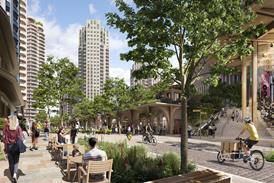The new line-up at the Housing Ministry needs to do some swotting over the summer, suggests Julia Park

There was never any doubt that Brexit would devour government time but the scale of the domestic policy voids that are opening up in all the key areas – health, housing, social care, education, the prison service – as a result of this particular strain of attention deficit disorder are worse than we might have feared.
Last November, the then communities secretary Sajid Javid promised a root and branch review of social housing. The Green Paper, promised in “the spring”, has yet to materialise. Javid has already moved on: sign-off will now rest with his successor, James Brokenshire, and Kit Malthouse, the new housing minister.
As BD reported this week, Brokenshire has made his first bold move in an open letter to the London mayor by threatening to intervene if Khan can’t “radically improve” his London Plan. Warning in a letter that the capital’s new homes target is too low, Brokenshire “reminded” Khan of his powers as secretary of state to direct a review to ensure a renewed housing plan is delivered. This ups the ante over the fact that average house prices in the capital are an “unacceptable” 12 times more than average earnings – compared with an England-wide ratio of less than eight and “far more than what an individual can typically expect to borrow for a mortgage”.
This threat completely ignores the dire shortfall Khan inherited from his predecessor and the obvious fact that needs-testing and target-setting (the main planks of the NPPF) achieve nothing in themselves. Johnson set a target of 40,000 new homes a year during his double term as mayor but only topped 20,000 in one of those eight years.
Despite the prime minister making housing reform a “personal mission”, we have seen nothing to suggest that any serious, creative thinking is taking place in government or that housing is any kind of priority. Instead, housing experts and providers, commentators and institutes are filling the policy void, some of them very well.
A Time for Good Homes: A Discussion Paper on Meeting the Needs of the Generation that Housing Forgot, a joint venture between Radian and the Housing & Finance Institute, published last week, is particularly good. Its main message – that private renting is not the answer – may not be universally popular but the case is well made.
Two years ago we fought hard to get the government to shake off its obsession with home ownership. For a substantial proportion of campaigners, that was about creating new homes for affordable and social rent, not about making it easier for the private sector to build to rent at market rents that few can afford, and that even fewer are occupying from choice.
In countries where renting works well, the cost, quality, management and length of tenure are all very different from the UK model, but this seems to have been overlooked. While the government is finally proposing three-year tenancies, decent standards and rent caps seem very unlikely.
We have seen nothing to suggest that any serious, creative thinking is taking place in government
The report begins by defining four pillars that define a good home: stability, flexibility, affordability and opportunity, before offering a wide range of excellent ideas for reform. It’s interesting that stability comes first. The professional private rented landlords’ body, ARLA, reports that the average private-renter moves home every 17 months, while the average homeowner now only moves every 17 years. There are other stark differences: private renters are twice as likely to experience loneliness as homeowners and over 70% report having experienced health and safety issues during their current tenancy.
The Bank of England, Shelter and other debt specialists agree that when housing costs start to reach 40-50% of housing income, financial problems tend to set in. The average private rent in London is already 49% of income. The average age of a first-time buyer is now 30, their average mortgage, £140,000, and the repayments 17% of average income. This is just under half the average rent paid by 16- to 34-year-olds over an equivalent period.
The authors point out that home ownership and social housing have proved to be the most stable and affordable tenures. It considers the longer-term implications of renting: things like having to compromise about when to start a family and being unable to save or make meaningful pension contributions. But its focus is the simple reality that the vast majority of renters want to buy their own home. Subject to being able to find a deposit, home ownership is not only much cheaper, it also yields a valuable asset. Ironically, while private renting has never been more expensive, mortgage costs have never been cheaper. Yet the private rental sector is booming, and home ownership declining.
Far from simply grumbling about a dysfunctional market, the report puts forward a 10-point plan:
1. Afford everyone the right to a good home that offers stability, flexibility, affordability and opportunity.
2. Establish a National Delivery Commission, working independently alongside government, to produce a 10-year delivery plan, scrutinised by parliament to ensure it meets the national interest.
3. Prioritise support for home ownership and social rent above other, less stable tenures.
4. Ensure that industrial strategies prioritise the right type of housing in the right locations to support job mobility and opportunity.
5. Introduce a housing stability target to ensure 90% of homes are in stable tenures (homeownership and social rent) by 2035, and set a minimum level of social housing provision.
6. Ensure that nomination agreements and local waiting lists secure fair and appropriate housing outcomes for all age groups in housing need and support the maintenance of sustainable, strong and balanced communities.
7. Extend and broaden home ownership support schemes through the Delivery Commission.
8. Consider the need to expand the Treasury Green Book to take better account of the contribution of good housing to an effective and productive economy.
9. Launch a Life Opportunities Market Renewal Programme with dedicated skills to transform lives and living conditions in the most deprived areas.
10. Recognise housing as a central pillar for the delivery of all other public services.
Each recommendation is supported by a number of really sensible ideas about how to deliver these goals in practice. For example (and not the first time this has been mooted) stamp duty could be more nuanced; paid by the vendor not the purchaser to help first-time buyers, but substantially reduced for older downsizers. Help to Buy could be means tested and spread more thinly because most mortgage lenders now accept substantially less than a 25% deposit. A new housing allowance tax scheme could allow young homeowners’ mortgage interest to be tax-deductible – a new form of MIRA. For young working renters, housing tax rebates could be linked to rental payments and paid directly into a housing ISA, contributing to a home deposit savings scheme.
The start of the school summer holiday has always been seen as a bad time to launch new publications. I’m not sure that’s right; this is perfect holiday reading for a new housing minister and secretary of state who have a huge amount to do back home once they unpack.
















2 Readers' comments